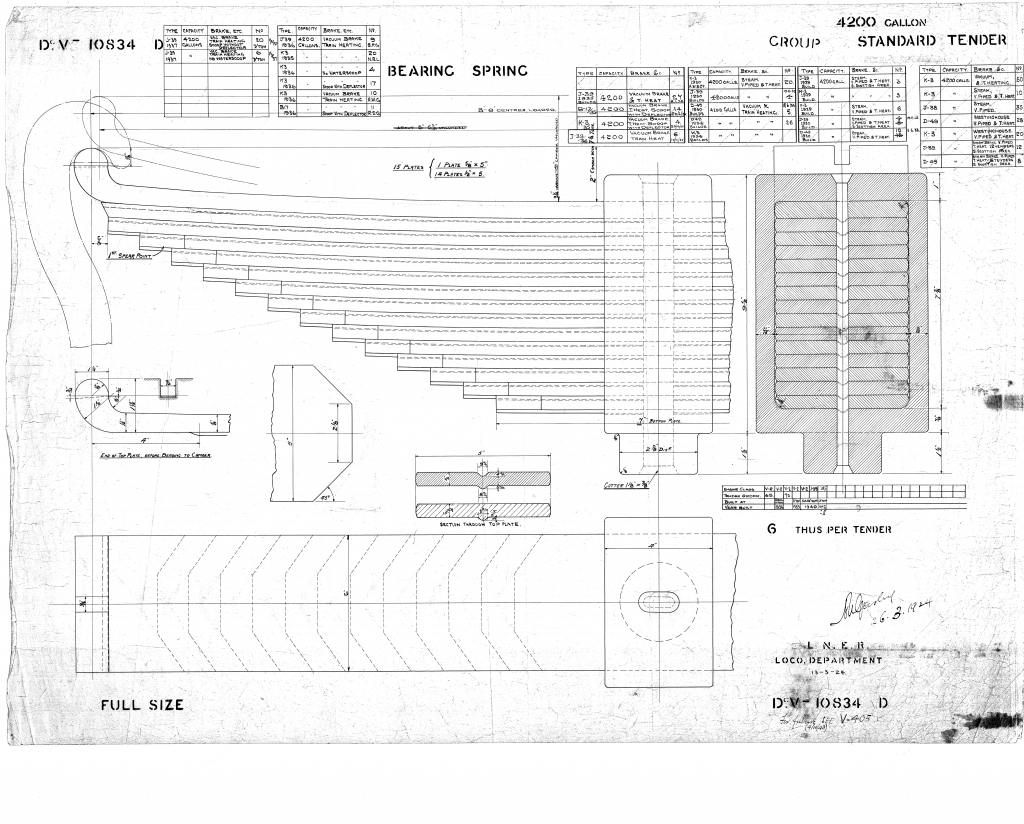Why would Network Rail—the company that owns and maintains Britain’s railways—need engineering drawings from the National Railway Museum’s collection that were produced at Darlington in 1924, to maintain a piece of rolling stock they still own and use today?
I was as surprised as most when the museum was approached to supply copies of the drawings. When I asked some of my colleagues the question above, none of them could think of the answer. The drawings Network Rail needed are even signed by LNER chief mechanical engineer Sir Nigel Gresley—the man who designed Flying Scotsman and Mallard. The drawings are quite mundane; they’re for the leaf springs (part of the suspension) on the group standard 4200 gallon tenders. These tenders were built by the LNER for a whole range of locomotives including the K3, K4, B1, B17, J39, D49 and V2 classes. So why would Network Rail need drawings for LNER tenders? After all, Network Rail don’t own any steam locomotives, right?

The answer? The drawings are for the independent snow ploughs, employed by Network Rail to keep the network clear of snow in winter months in order to keep it running. Network Rail employ a range of different types of snow plough to keep the tracks clear in winter – ranging from mini snow ploughs (MSP) fitted to the front of locomotives, which can clear up to 18 inches of snow, to the much larger independent snow ploughs (ISP) and even a couple of snow blowers. Network Rail needed the drawings for the larger ISPs – they were built by British Railways in the 1960s, but to save money they were built on top of the redundant frames from tenders of former LNER locomotives. The locomotives were being scrapped at the time so the tender frames were in ample supply and perfect for the task. At the end of this year’s snow season, Network Rail are beginning the process of overhauling the snowploughs so they can continue to be used well into the future—hence the need for the drawings.

Owing to climate change, the ploughs do not see as much regular use as they used to. The larger ISPs are primarily used for clearing large snow drifts and until a few weeks ago it had been a few years since they had last seen any use. However, recent weather has shown just how important it is to maintain this fleet ready for the next snowy day. With heavy drifting snow across parts of Britain, especially in Scotland where a rare red weather warning was issued by the UK Met Office, the ploughs were out clearing drifts up to 10 feet deep. Take a look at the video and pictures below to get an idea of what they were up against.

Special thanks to Network Rail for their kind permission to reproduce the images and videos above.
This was an interesting article, backed by a great video.
A very interesting nugget this. There are many (smaller, “lesser”) items around Britain’s railway’s which are from a “bygone age”, but which still perform a useful/vital job, even in the “computer age”. Older designs which just WORK, reliably, without costing lots of money or effort to maintain.
I REMEMBER THIS HAPPENING AT THE TIME. WHAT YOUR ARTICLE FAILS TO MENTION IS THAT IN ORDER TO GET THE TENDERS TO SWINDON WORKS THEY WERE BROUGHT AS A COMPLETE ENGINE AND TENDER UNIT AND WHAT WAS NOT REQUIRED – THE V2 LOCOMOTIVES AND TENDER TOPS WERE CUT UP AT SWINDON.